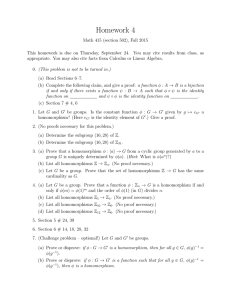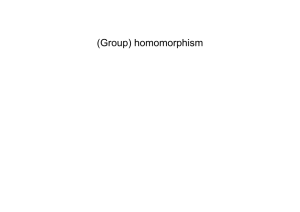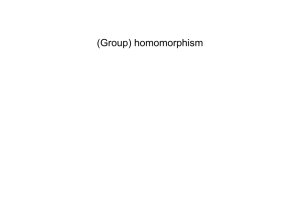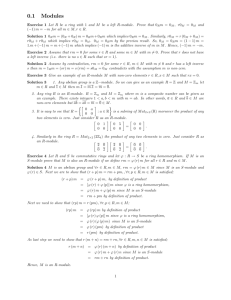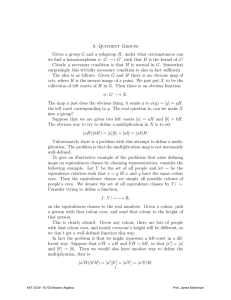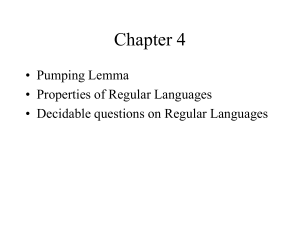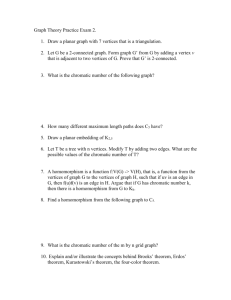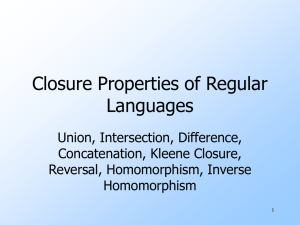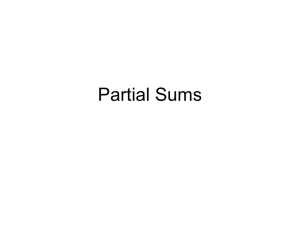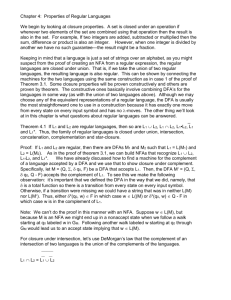FREE GROUPS - Stanford University
advertisement
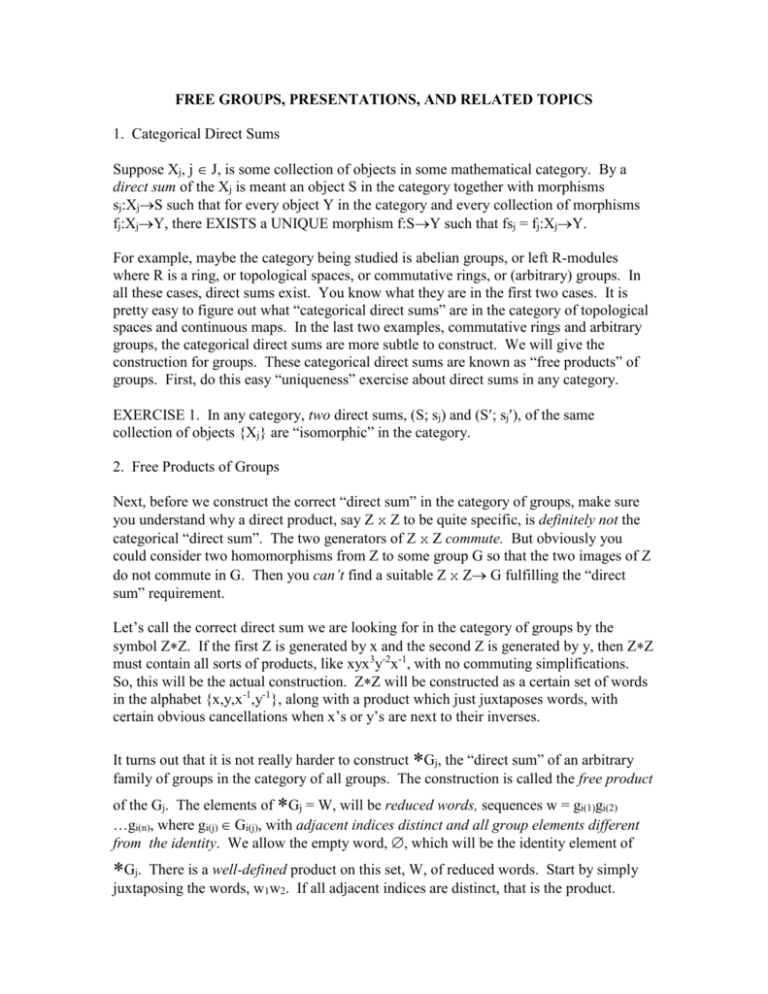
FREE GROUPS, PRESENTATIONS, AND RELATED TOPICS
1. Categorical Direct Sums
Suppose Xj, j J, is some collection of objects in some mathematical category. By a
direct sum of the Xj is meant an object S in the category together with morphisms
sj:XjS such that for every object Y in the category and every collection of morphisms
fj:XjY, there EXISTS a UNIQUE morphism f:SY such that fsj = fj:XjY.
For example, maybe the category being studied is abelian groups, or left R-modules
where R is a ring, or topological spaces, or commutative rings, or (arbitrary) groups. In
all these cases, direct sums exist. You know what they are in the first two cases. It is
pretty easy to figure out what “categorical direct sums” are in the category of topological
spaces and continuous maps. In the last two examples, commutative rings and arbitrary
groups, the categorical direct sums are more subtle to construct. We will give the
construction for groups. These categorical direct sums are known as “free products” of
groups. First, do this easy “uniqueness” exercise about direct sums in any category.
EXERCISE 1. In any category, two direct sums, (S; sj) and (S; sj), of the same
collection of objects {Xj} are “isomorphic” in the category.
2. Free Products of Groups
Next, before we construct the correct “direct sum” in the category of groups, make sure
you understand why a direct product, say Z x Z to be quite specific, is definitely not the
categorical “direct sum”. The two generators of Z x Z commute. But obviously you
could consider two homomorphisms from Z to some group G so that the two images of Z
do not commute in G. Then you can’t find a suitable Z x Z G fulfilling the “direct
sum” requirement.
Let’s call the correct direct sum we are looking for in the category of groups by the
symbol ZZ. If the first Z is generated by x and the second Z is generated by y, then ZZ
must contain all sorts of products, like xyx3y-2x-1, with no commuting simplifications.
So, this will be the actual construction. ZZ will be constructed as a certain set of words
in the alphabet {x,y,x-1,y-1}, along with a product which just juxtaposes words, with
certain obvious cancellations when x’s or y’s are next to their inverses.
It turns out that it is not really harder to construct Gj, the “direct sum” of an arbitrary
family of groups in the category of all groups. The construction is called the free product
of the Gj. The elements of Gj = W, will be reduced words, sequences w = gi(1)gi(2)
…gi(n), where gi(j) Gi(j), with adjacent indices distinct and all group elements different
from the identity. We allow the empty word, , which will be the identity element of
Gj.
There is a well-defined product on this set, W, of reduced words. Start by simply
juxtaposing the words, w1w2. If all adjacent indices are distinct, that is the product.
Otherwise, the last index of the first word must agree with the first index of the second
word, w1w2 =
( ….gj)(hj…) with gj and hj both in Gj. Reduce the word by replacing these two letters by
the single element gjhj Gj. If that product is not the identity element of Gj, you are
finished. If that product is the identity in Gj, remove it. Iterate this procedure with the
resulting simplified word until a reduced word is obtained. The only possible
simplifications and cancellations occur where remnants of the two original words meet,
no choices are ever made about where to simplify, so the product is well-defined. Write
the reduced product of two words as [w1][w2]
The only difficulty in showing that this set of reduced words, W, with the product just
defined, is a group, is the proof of the associative law. Identity element, , and inverses,
are obvious. The problem with associativity is that when three words are juxtaposed, you
must perform simplifications in two different orders, so it isn’t immediate that you
always end up with the same reduced word. This is a technical difficulty, which must be
handled one way or another. I’ll follow a clever approach which embeds W in a product
preserving way in the group SW of all permutations of the set W.
Define uj:GjSW by the rule uj(gj)(w) = [gj][w]. The understanding is [1j] = W, if
1j Gj is an identity element. Note the following exercise is essentially a very special
case of associativity in W.
EXERCISE 2. [gjhj][w] = [gj]([hj][w]). Hence uj:GjSW is a group homomorphism.
Now define u:WSW by composing permutations, that is u(gi(1)gi(2) …gi(n)) =
u(gi(1))u(gi(2)) …u(gi(n)). Then the following exercise is exactly the statement of the
desired associativity of the product on W, ([w1][w2])([w] = [w1]([w2][w]), but the proof
just uses the definition of u, the definition of the product in W, and Exercise 2, and avoids
actually dealing with three general elements of W.
EXERCISE 3. u([w1][w2]) = u([w1])u([w2]).
OK, we now have a group structure on the set of reduced words
Gj = W, and we have
obvious group homomorphisms sj:GjGj, since an element of Gj is a (short) word in
W.
EXERCISE 4. (Gj; sj) is a categorical direct sum of the Gj in the category of groups.
3. Free Groups and Free Objects
Suppose each Gj Z, an infinite cyclic group. The resulting free product is called a free
group. Suppose X is any set. For each xj X, let Zj = <xj> Z denote an infinite cyclic
group with generator xj. A homomorphism sj:ZjH is the same data as an element hj
H, since the element hj = sj(xj) determines the homomorphism. Therefore, the free group
F(X) = Zj has the following universal property:
Let i:XF(X) denote the obvious inclusion of the given set of generators of the Zj into
Zj = F(X). For any group H and any function f:XH, there EXISTS a UNIQUE group
homomorphism :F(X)H such that i = f.
Note there is a categorical similarity here with the concept of a basis of a vector space, or
more generally a basis X of a free module, F, over any ring. X is a subset of F so that
every function f:XN, where N is any module, extends to a unique module
homomorphism :FX. This universal property defines free objects in any category in
which the objects are sets and the morphisms are functions. If X is a set and i:XF is a
function, where F is an object in some such category, then (F;i) is the free object on the
set X in the category if for every function f:XN from set X to an object N in the
category, there EXISTS a UNIQUE morphism :FN in the category such that i = f.
Another familiar example is found in the category of commutative rings with unit. The
free object on X is the polynomial ring Z[X], that is, polynomials on symbols xj X.
The universal proof about uniqueness up to isomorphism of objects satisfying some
universal property, shows that if a free object on X exists then it is unique up to
isomorphism.
In the case of free groups, each non-identity element of F(X) has a unique expression
(xj(1))e(1)(xj(2))e(2)…(xj(n))e(n), where the e(j) are non-zero integers and adjacent xj’s never
coincide. The multiplication is juxtaposition, followed by combining powers of any
resulting adjacent terms involving the same xj, and erasing identity elements if they
occur. This perhaps seems somewhat more elementary and explicit than our previous
construction of the free product of an arbitrary family of groups, but one has the same
technical difficulties with associativity in this special case as one has in the general
construction.
A rather remarkable theorem is that any subgroup of a free group is also a free group.
But one can’t say much about the number of generators. If n is a positive integer, or if n
is 0, then the free group on 2 generators contains subgroups that are free on n
generators. However, here is one result about the number of generators of a free group.
EXERCISE 5. If F F, where F and F are free groups on sets X and X, respectively,
then |X| = |X|. (If you are stuck here, do Exercise 6 below first.)
4. Generators and Relations
If G is a group and R G is a subset, what is the smallest normal subgroup N(R) G
which contains R? The answer is obviously this: N(R) is the set of all finite products of
conjugates of elements of R and their inverses. These products must be contained in any
normal subgroup of G that contains R, and this set of products is a normal subgroup of G.
The quotient projection p:GG/N(R) clearly has the following universal property. If
f:GH is a group homomorphism with R kernel(f), then there exists a unique
homomorphism :G/N(R) H such that f = p:GG/N(R) H.
If X = {xj} is a set and R = {ri} F(X) is a subset of the free group on generators X, that
is, R is a set of words, then the notation <xj | ri > = F(X)/N(R) is used to denote the group
“generated by set X subject to relations R”. If f:XH is any function from X to a group
H such that f(rj) = 1 H for all rj R, then there exists a unique group homomorphism
:F(X)/N(R) H “extending” f. This universal property characterizes <xj | ri > up to
isomorphism.
It is very difficult to determine, in fact, in complete generality impossible to determine,
whether a group presented with given generators and relations is a finite group or even a
non-trivial group. It is also impossible to determine in general whether two words in
F(X) become equal in F(X)/N(R). However, given an explicit group G, such as a
symmetric group or a semi-direct product group or a matrix group, it is often possible to
identify generators and relations which present G, that is, prove G <xj | ri >, for certain
elements xj G satisfying relations given by words ri.
EXERCISE 6. Show that < xj | xjxj(xj)-1(xj)-1 all j,j > is the free abelian group (i.e. direct
sum of Z’s) with basis X = {xj}. Do this the right way, namely, by showing that the
group in question is abelian and has the correct universal property in the category of
abelian groups.
5. Amalgamated Products
Suppose G and H are two groups and g:KG and h:KH are two homomorphisms from
a third group K to G and H, respectively. Define the amalgamated product GK,g,hH to
be the group (GH)/N(R), where R = {g(x)h(x-1) | all x K}. In other words, in the free
product GH, impose relations which force the two images of x K to coincide.
EXERCISE 7. Show that GK,g,hH, together with the two obvious homomorphisms
u:G GK,g,hH and v:H GK,g,hH, has the following universal property: For every
group L and every pair of homomorphisms p:GL and q:HL such that pg = qh:KL,
there exists a unique homomorphism : GK,g,hHL such that u = p and v = q.
Of course this exercise is trivial, you just quote two other universal properties. One could
construct more elaborate amalgamated products involving several ingredient groups and
homomorphisms. But this basic amalgamated product occurs very naturally in topology,
providing a computation of the fundamental group of certain unions of two topological
spaces, in terms of the fundamental groups of the separate spaces and their intersection.
It is useful to not be intimidated by the algebraic details underlying the construction of
this group.
